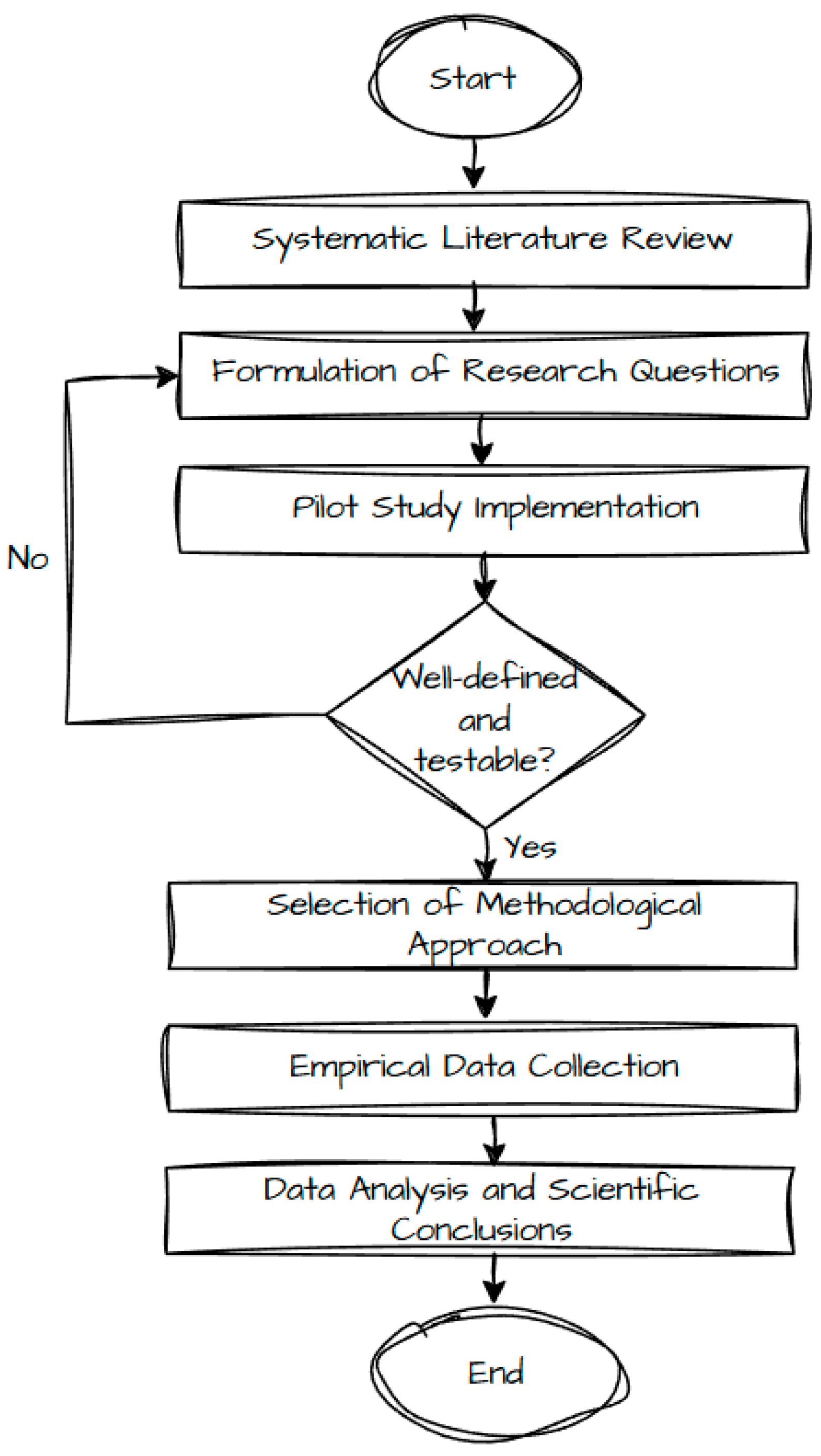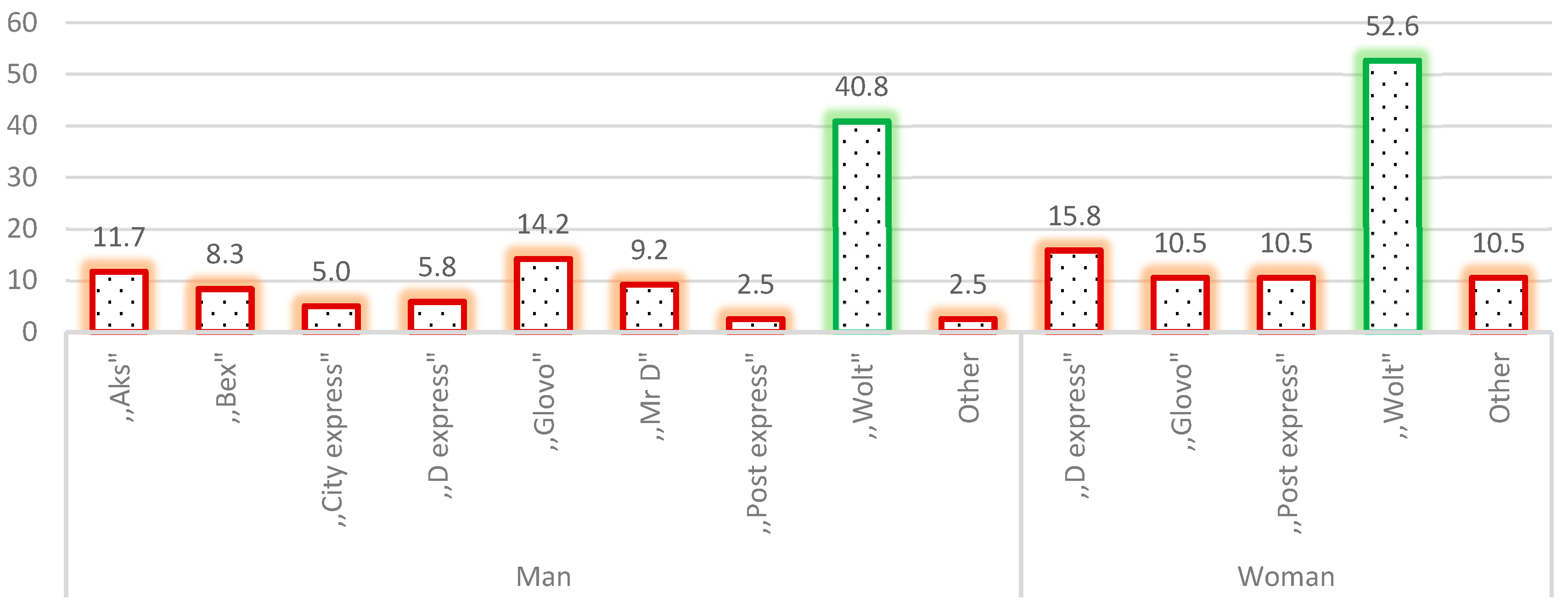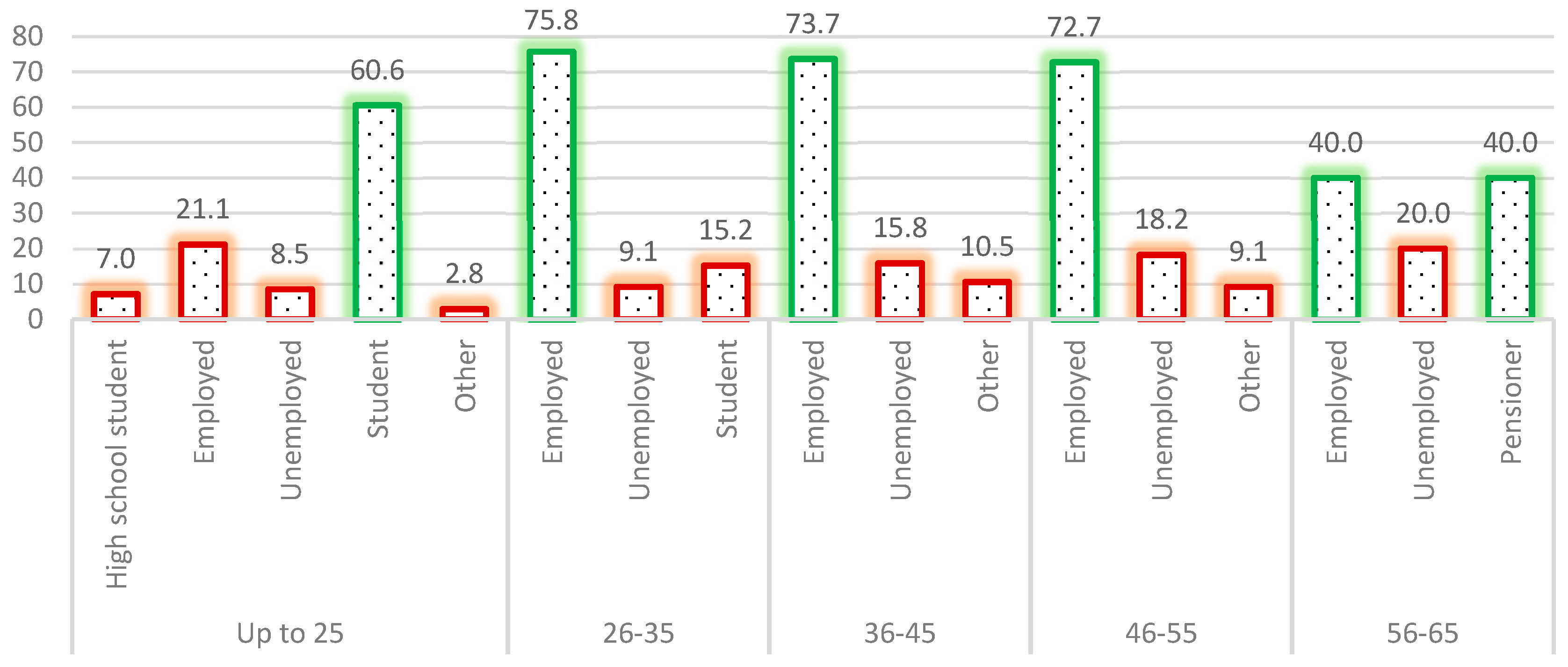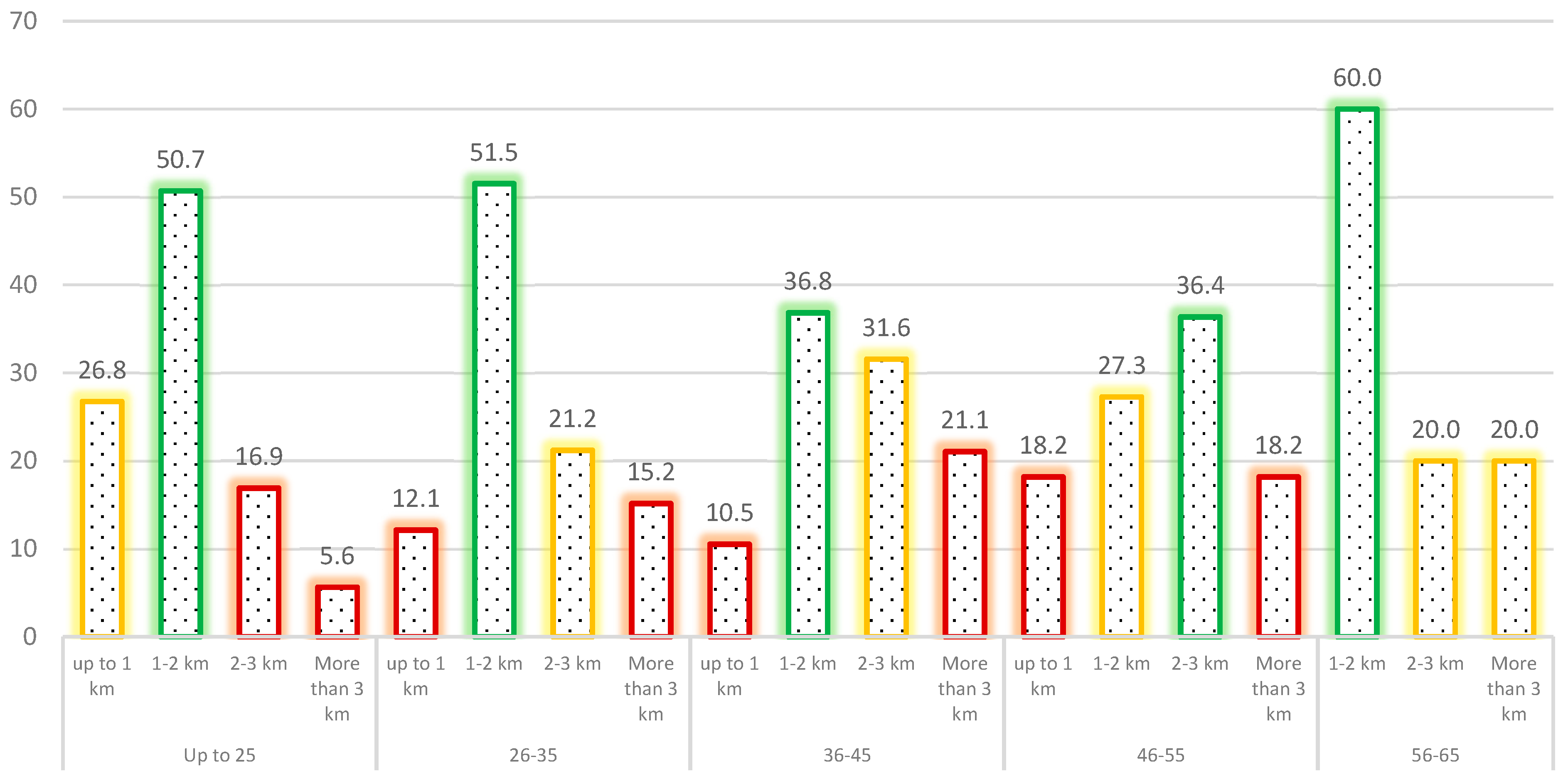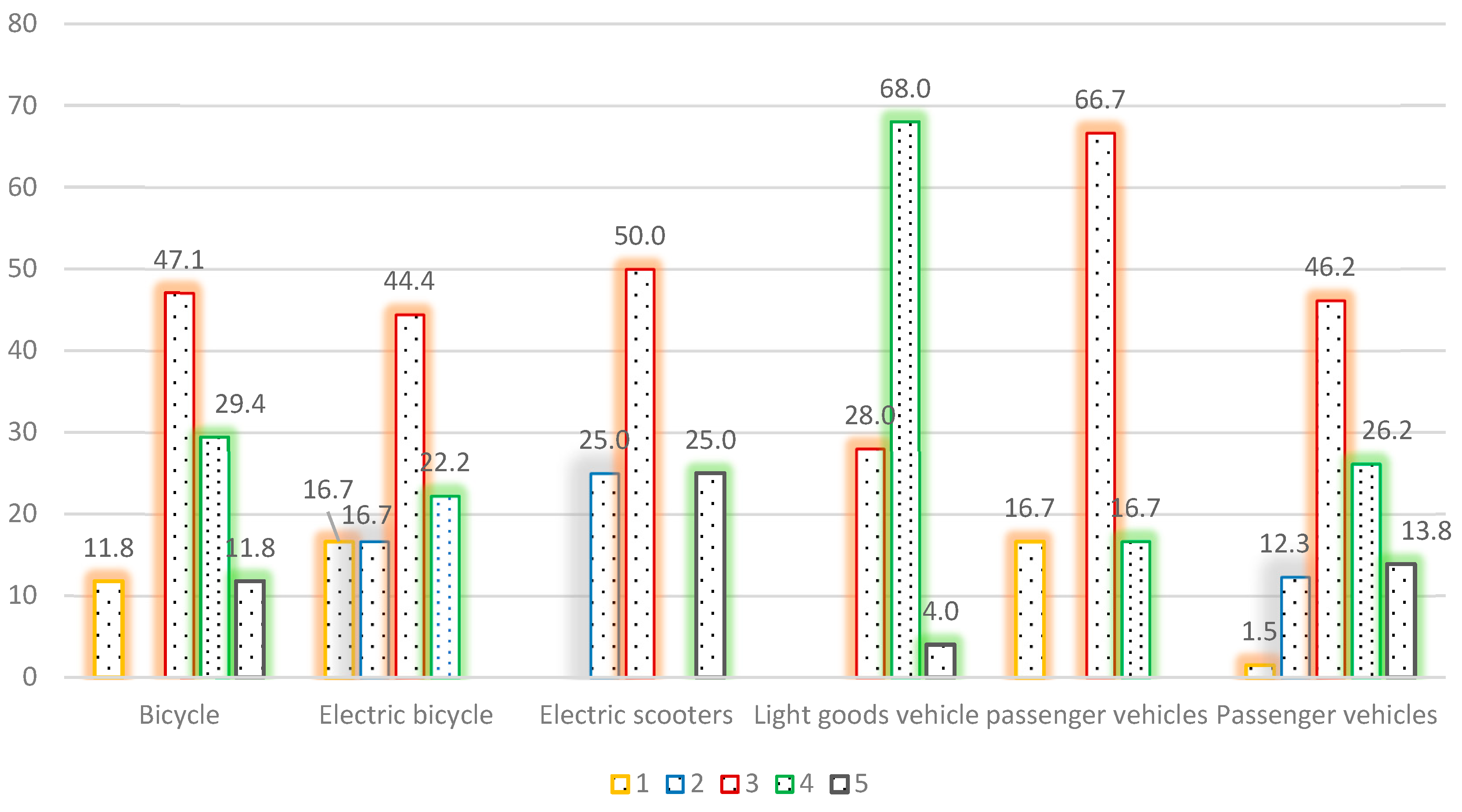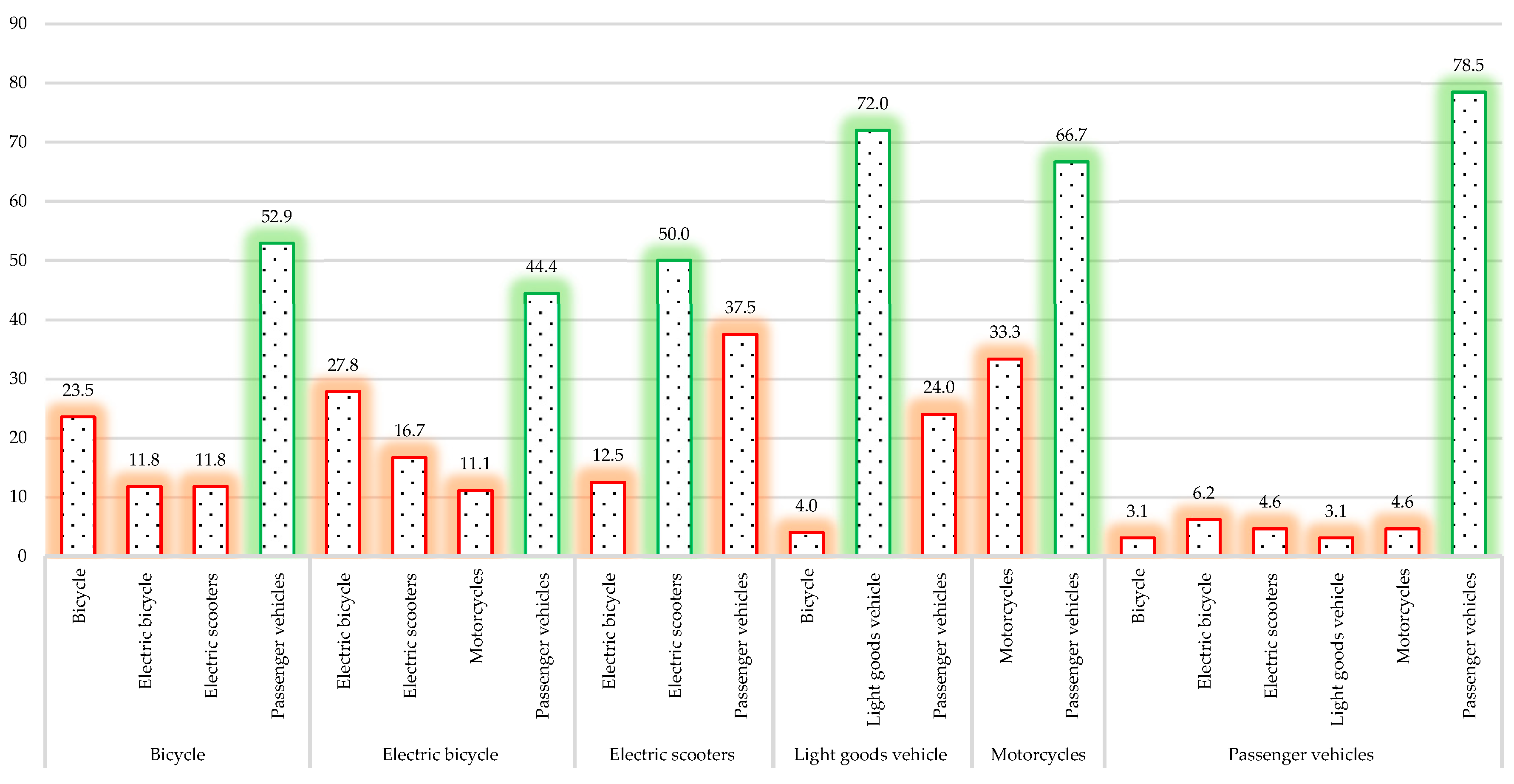1. Introduction
Cities represent places of great concentration of population [
1], places of economic and social activities [
2], as well as places where large quantities of goods are generated [
1]. Freight transport in urban areas, that is, delivery of goods, is a basic prerequisite for the life and work of the population [
1,
3,
4] and activities in urban city areas [
5], and with which wealth and development of urban areas are achieved [
1]. In Europe, more than half of the population lives in urban areas [
6,
7], and by 2050, this percentage is expected to reach 68% [
8]. About 80% of the world’s and about 85% of the EU’s GDP is generated in urban areas [
1].
Urban city environments represent a “complex” system because the area of cities represents both the area for the transportation of goods, as well as the area for loading, shipment and unloading of goods [
1,
9,
10]. About two-thirds of the total goods flows start or ends in cities, which indicate the importance and problems of the organization of freight transport in urban areas [
1]. The increasing population, expansion, lack of transport infrastructure, as well as other negative effects and consequences make traffic in urban areas face great problems and consequences, but also numerous difficulties [
4,
6,
11].
The COVID-19 pandemic additionally accelerated these challenges by drastically changing consumer behavior, intensifying e-commerce growth, and reshaping last-mile logistics needs [
12,
13]. The measures aimed at restricting the spread of the virus, primarily referring to limiting the physical interaction of the population [
14,
15,
16], have contributed to directing customers to online shopping. Bearing the above in mind, it can be concluded that the challenges imposed by the COVID-19 pandemic “triggered” and enabled the rapid development of new trends in logistics. The change in the way of shopping, i.e., online shopping, has influenced the creation of new requirements for the organization of transport, such as home delivery [
9,
17]. The increase in online shopping is directly related to the increase in the number of deliveries to home addresses [
1]. The rapid growth of e-commerce fueled by the Internet and the emergence of the COVID-19 pandemic, the increase in the demand of goods deliverers caused by the increase in sales on the Internet and the development of various modes of transport have stimulated the development of the courier industry [
18,
19,
20]. The interaction between transportation systems and the COVID-19 pandemic has also been highlighted in international research, confirming its disruptive role on mobility and logistics systems [
21,
22,
23,
24].
Today, online shopping is one of the most popular forms of shopping in the entire world and is growing constantly [
3]. In Great Britain, online shopping accounted for 59% of total purchases in 2004, while in 2000 it accounted for 49% [
3]. In the Republic of Serbia, 45.4% of all Internet users have never bought anything using the Internet [
15,
25]. In the USA, sales of products and services, between February and April 2020, decreased by 7.7%, compared to the same period in 2019. However, the increase is recorded by facilities, i.e., companies that based their business on online shopping and online ordering of products and services, and this is because in April 2020, a 30% higher demand for online shopping was recorded, compared to 2019. Online shopping is also growing in China, where the share of online shopping reached 24.6% in August 2020, compared to 19.4% in August 2019 and 17.3% in August 2018 [
15]. Although there are no official statistics for most other countries, it is estimated that online shopping in the first quarter of 2020 saw growth in several regions, namely Europe, North America and Asia [
15,
16]. Online shopping has gained special importance when it comes to supplying the population with food. Namely, small, medium and large food producers delivered their products directly to consumers, i.e., the population, as well as to restaurants that switched to providing food delivery services [
15]. Despite this rapid growth, there are persistent challenges in courier operations such as service reliability, delivery delays, and safety risks for drivers. Previous studies have mostly focused on customers’ perception of service quality, while the perspectives of delivery personnel remain underexplored [
26,
27,
28,
29]. Related driving simulator studies emphasize the importance of road safety perception and operational risks, which complements the focus of this study on courier drivers [
30,
31,
32]
In the Program for the Development of Electronic Commerce in the Republic of Serbia, it was stated that the unreliability of courier services that deliver goods is a key threat to electronic commerce, with 44% [
25]. It often happens that consumers are dissatisfied with the service or delivery [
3,
33,
34]. In the research conducted by Ivanišević and Simović [
14] in 2020, to the question related to the assessment of the quality of courier services during the COVID-19 pandemic, it can be concluded that a very small percentage of respondents (9.9%) rated the services of courier services as 5 (high). The highest percentage of respondents gave a rating of 3 (medium) and that was 43.7% of the respondents, followed by a rating of 4 (moderately high) and that was 35.2% of the respondents. 8.5% of respondents rated the service quality as 1 (low), while 2.8% rated it as 2 (moderately low). As the most common reason for the “bad” evaluation of the quality of the courier services, the largest percentage (56.9%) of the respondents stated, “exceeding the delivery time”. In 43.1% of respondents, they cited reasons related to “the parcel was not delivered to my home (desired) address, but to another (unwanted) address”, “unkindness of the staff”, “damage to the parcel” and “non-arrival of the courier even though service request sent” [
15]. According to the results of the research carried out in 2018, in Serbia, every fifth buyer or user had a bad experience when buying online, and as a reason in 21% of cases, users stated that they waited too long for the ordered goods [
15,
25,
35], and which indicates a problem in the organization of transport in road traffic. The customer’s perception of the quality of the service primarily depends on the length of the defined necessary time interval for the delivery of the goods and on the accuracy of the delivery of the goods in the defined time interval [
1,
36,
37]. Dissatisfaction of buyers, i.e., users of online shopping, was especially expressed in Serbia during the COVID-19 pandemic, where one of the reasons could be the increase in the volume of business of courier services, as well as insufficiently good organization of traffic, i.e., freight transport [
15,
38,
39].
Taking all of the above into account, it becomes evident that while consumer satisfaction has been extensively studied, the perspectives, safety perceptions, and preferences of courier drivers themselves have been largely neglected [
40,
41,
42]. This gap is particularly significant because drivers are key actors in last-mile delivery and their attitudes directly affect both efficiency and safety. Accordingly, this paper examines the attitudes and perceptions of courier service providers in Serbia, with a focus on demographic, operational, and safety-related factors that influence their work. The study makes three main contributions: (i) it provides empirical evidence on courier drivers’ perceptions in a transitional economy context, (ii) it highlights factors that may inform better alignment between drivers’ needs and company strategies, and (iii) it offers practical recommendations for improving both service quality and driver safety.
By linking findings from Serbia to broader global trends in e-commerce and logistics, the paper also contributes to the international debate on sustainable and safe last-mile delivery. Recent studies emphasize efficiency and sustainability improvements in parcel delivery operations, particularly within private courier companies [
43,
44,
45], while optimization approaches to freight transport systems provide methodological insights relevant to courier logistics [
46,
47,
48]. Building on this research gap, the present study is guided by the following research questions: Which demographic factors shape courier drivers’ perceptions and preferences? How do operational parameters (type of goods, delivery distance, and means of transport) affect their attitudes? To what extent do safety perceptions and the tolerance of other road users influence efficiency and satisfaction in courier services? The objectives of the study are: (i) to empirically test group differences across eleven predefined hypotheses (H
1–H
11), (ii) to identify patterns that are especially relevant to operational efficiency and road safety, and (iii) to extend the literature by shifting focus from consumer satisfaction to the perspective of delivery personnel.
2. Materials and Methods
The research was conducted with respondents employed in different courier services in the Republic of Serbia. In total, 139 respondents participated in the study. The questionnaire, created in Google Forms, was sent to the official e-mails of courier services. The e-mail text contained all the necessary information about the survey, as well as a link to the online questionnaire. Potential respondents were selected randomly and participation was voluntary [
49]. The study was conducted in accordance with the Code of Ethics and Behavior of the Serbian Psychological Society [
49,
50]. Respondents did not receive any compensation for their participation [
49,
50]. Prior to the main survey, a pilot study was carried out with 90 respondents, based on which improvements of the methodology were made.
The final sample of 139 respondents represented drivers from eight courier companies (including Wolt, Glovo, Aks, Mr. D, Bex, D Express, City Express, and Post Express). Some companies declined to participate, which limited the diversity of the sample. Respondents indicated that the majority of deliveries were made directly to home addresses (approximately 85%), while a smaller proportion were directed to parcel lockers (about 15%). The questionnaire was distributed to around 350 drivers across these companies, and 139 completed responses were obtained, corresponding to a response rate of about 40%.
The survey included 16 closed-ended questions relating to demographic characteristics (gender, age, place of residence, occupation), possession of a driver’s license (and its duration), courier service of employment, type of goods delivered, area of delivery, means of transport used, perception of road safety during delivery, the influence of traffic jams on delivery time and quality, tolerance of other road users towards couriers, minimum and maximum delivery distances (one direction), and the desired means of transport for deliveries from the aspect of road safety. In this study, two separate variables were analyzed: respondents’ place of residence and delivery area. Respondents’ place of residence refers to the area where the driver lives (urban, suburban, or rural), while delivery area refers to the geographic zone in which the driver performs deliveries (city center, wider city area, or suburban area). Operational parameters such as delivery distance (minimum and maximum), and type of goods were explicitly included in the survey design and statistically analyzed as factors influencing delivery choices.
The questions related to the perception of road safety, the impact of traffic jams, and the tolerance of other road users were measured using a five-point Likert scale, where 1 indicated the lowest level (e.g., very unsafe/no impact/very low tolerance) and 5 indicated the highest level (e.g., very safe/very strong impact/very high tolerance).
The data were collected through an on-line questionnaire and then imported in the software package MS Excel, version 2019 [
12,
51]. After importing, the data were examined and validated [
12]. Next, the statistical analysis of the obtained data was conducted in the software package IBM SPSS Statistics, version 29.0 [
12,
51]. Normality of distribution was tested by inspection of histograms and the Kolmogorov–Smirnov test. Since the data for all measured variables distribution were normally distributed, we used parametric methods. To assess the significance of differences the Independent Samples
T-Test, Paired-Samples
T-Test and One-way ANOVA were used [
12,
49,
51,
52]. The Tukey post hoc test was used for the additional comparison between groups [
50]. In addition to testing for statistical significance, the strength of connections was assessed using effect size (η
2). For interpretation, the thresholds were: small (<0.06), moderate (0.06–0.14), and large (≥0.14).
The null hypothesis (H0) was: There is no statistically significant difference between the perceptions and attitudes of courier service providers. The alternative hypotheses (Ha) were:
Hypothesis 1 (H1). There are statistically significant differences for the analyzed perceptions and attitudes of courier services drivers by gender;
Hypothesis 2 (H2). There are statistically significant differences for the analyzed perceptions and attitudes of courier services drivers in terms of age;
Hypothesis 3 (H3). There are statistically significant differences for the analyzed perceptions and attitudes of courier services drivers according to their place of residence;
Hypothesis 4 (H4). There are statistically significant differences for the analyzed perceptions and attitudes of courier services drivers according to occupation;
Hypothesis 5 (H5). There are statistically significant differences for the analyzed perceptions and attitudes of courier services drivers in terms of having a driver’s license;
Hypothesis 6 (H6). There are statistically significant differences for the analyzed perceptions and attitudes of courier services drivers according to the years (length) of possessing a driver’s license;
Hypothesis 7 (H7). There are statistically significant differences for the analyzed perceptions and attitudes of courier services drivers according to the type of delivered goods;
Hypothesis 8 (H8). There are statistically significant differences for the analyzed perceptions and attitudes of courier services drivers according to the area where the goods are delivered;
Hypothesis 9 (H9). There are statistically significant differences for the analyzed perceptions and attitudes of courier services drivers according to the means of transport used to deliver the goods;
Hypothesis 10 (H10). There are statistically significant differences for the analyzed perceptions and attitudes of courier services drivers according to the evaluation of road safety;
Hypothesis 11 (H11). There are statistically significant differences for the analyzed perceptions and attitudes of courier services drivers according to the desired means of transport for the delivery of goods, viewed from the aspect of road safety.
The threshold for the statistical significance (a) was set to 5%. Consequently, if probability (p) is smaller or equal to 0.05, H0 is rejected, and Ha is accepted. On the contrary, if p > 0.05, H0 is not rejected.
Figure 1 illustrates the sequential structure of the research process through a flowchart, beginning with a systematic literature review and the formulation of research questions. A pilot study is then conducted to refine the design, followed by a decision stage assessing whether the research questions are well-defined and testable. If not, the process loops back to earlier stages to ensure clarity and validity. Once the questions are properly established, the methodological approach is selected, leading to empirical data collection and, subsequently, data analysis and the formulation of scientific conclusions. The diagram emphasizes the iterative nature of research design, ensuring methodological rigor, reliability, and the alignment of outcomes with the stated objectives.
3. Results
Altogether, 139 respondents participated in the research. The share of male respondents in the sample is 86.3%, while the share of female respondents is 13.7%. More than half of the sample, 51.1% of respondents, were young road users under the age of 25, 23.7% were respondents aged 26 to 35, while 13.7% were respondents aged 36 to 45. The highest percentage, 24.5%, of the respondents stated that they live in the city center (wider city area), 18.7% in the city center (inner-city area), while 15.8% of the respondents stated that they live in the suburbs. Almost half of the respondents, 46%, stated that they were employed, while 34.5% of the respondents stated that they were students. 93.5% of respondents stated that they have a driver’s license, with the largest percentage, 38.1%, of respondents having a driver’s license for 2 to 5 years, 20.1% of respondents for 5 to 10 years, while 13, 7% of respondents have a driver’s license for a period of 1 to 2 years.
All 139 respondents are employed in courier services, with the highest percentage, 42.4% of respondents employed in the courier service “Wolt”, while 57.6% of respondents are employed in other courier services (13.7% in “Glovo”, 10.1% in “Aks”, 7.9% in “Mr. D”, 7.2% each in “Bex” and “D express”, 4.3% in “City express”, 3.6% each in “Post express” and “City express”). 49.6% of respondents most often deliver food, 13.7% of respondents deliver an assortment from the market, while 36.69% of respondents deliver other goods (clothes, shoes, flowers, medicines, etc.). 46.8% of respondents deliver goods in wider city area and inner-city area, 30.2% of respondents only in inner city area, while 23% deliver goods exclusively in the wider city area. The largest percentage of respondents, as much as 46.8%, stated that they deliver goods by passenger vehicle, 25.2% by bicycle (12.2%) and electric bicycle (12.9%), 18% by light goods vehicle, 5.8% by electric scooter and 4.3% by motorcycle. The minimum distance covered by respondents during one delivery in the largest percentage of cases, for 47.5% of respondents, is from 1 to 2 km, 21.6% of respondents cover from 2 to 3 km, 19.4% cover up to 1 km, while 11.5% of respondents during delivery travel more than 3 km for one delivery. The maximum distance covered by respondents during one delivery for 43.9% of respondents is over 3 km, for 30.9% of respondents it is from 3 to 4 km, while for 25.2% of respondents this distance is from 2 to 3 km. On a scale from 1 to 5, 43.9% of respondents rated the level of road safety as 3, 31.7% of respondents rated it as 4, 10.1% as 5, 9.4% as 2 and 5% of respondents rated the level of road safety as 1. Also, on a scale from 1 to 5, the respondents estimated how much traffic jams affect the time and quality of delivery. The largest percentage of respondents, 30.2%, rated the impact of traffic jams on the time and quality of goods delivery as 4, 26.6% as 5, 24.5% as 3, 12.2% as 2 and 6.5% as 1. The level of tolerance of other road users, on a scale from 1 to 5, was rated by the highest percentage (32.4%) of respondents as 3, 25.9% as 4, 24.5% as 2, 11.5% as 1 and 5.8% of respondents rated the level of tolerance as 5. When asked which means of transport they would choose for delivery, and viewed from the aspect of road safety, the respondents in the highest percentage (58.3%) choose a passenger vehicle, 14.4% of respondents choose a light goods vehicle, 13.67% choose a bicycle (5%) and electric bicycle (8.6%), 8.6% choose an electric scooter and 5% of respondents choose a motorcycle.
3.1. Analysis of Respondents’ Attitudes by Gender
The Independent Samples
T-Test was used to examine the differences in the respondents’ attitudes, depending on the gender of the respondents. The Independent Samples
T-Test shows that there are statistically significant differences between courier services drivers and gender of respondents (F = −3.174;
p = 0.003), as well as between the age and gender of the respondents (F = 2.197;
p = 0.030). The percentage of respondents by gender and courier services drivers in which the respondents are employed is shown in
Figure 2, while the percentage of respondents according to gender and age is shown in
Figure 3.
3.2. Analysis of Respondents’ Attitudes According to Their Age
The highest percentage of respondents under the age of 25 who work as courier service drivers by profession are students, as much as 60.6%. Respondents aged 26 to 55 in the largest percentage of cases are employed who do delivery as a basic or part-time (additional) job, while respondents aged 56 to 65 are mostly pensioners (40% respondents) and employed (40% of respondents) (
Figure 4).
The minimum distance covered by respondents during one delivery, for all age categories except for the category of 46 to 55 years old, in the largest percentage, is from 1 to 2 km. For the age category of 46 to 55 years, in the largest percentage (36.4%), the minimum distance covered by respondents for one delivery is 2 to 3 km (
Figure 5).
One-way ANOVA was used to examine the differences in the respondents’ attitudes, depending on the age of the respondents. The results of the One-way ANOVA show a significant statistical difference between respondents with different ages and occupations (F = 5.570; p < 0.001), year of possession of the driver’s license (F = 32.611; p < 0.001), courier service company (F = 6.844; p < 0.001), evaluations of the impact of traffic jams on the time and quality of delivery (F = 2.491; p = 0.046), as well as between the age of the respondents and the minimum distance that the respondents cover during one delivery (F = 2.913; p = 0.024).
3.3. Analysis of Respondents’ Attitudes According to Socio-Demographic and Licensing Characteristics
The results of the One-way ANOVA reveal several statistically significant differences when respondents are grouped by place of residence, occupation, and driver’s license characteristics. With regard to place of residence, significant differences were found between respondents from different areas and the courier service providers they work for (F = 2.667; p = 0.018). Moreover, respondents’ evaluation of the impact of traffic jams on delivery time and quality also varied significantly depending on their place of residence (F = 2.475; p = 0.027). In terms of occupation, notable differences were observed in the possession of a driver’s license (F = 2.380; p = 0.042), the perceived tolerance of other road users towards courier drivers (F = 2.308; p = 0.048), and the minimum distance covered during a single delivery (F = 3.965; p = 0.002). Differences also emerged when considering the possession of a driver’s license. Respondents with and without a license significantly differed in both the minimum (F = 4.145; p = 0.044) and maximum (F = 8.471; p = 0.004) distances covered during deliveries. Finally, the length of possessing a driver’s license also influenced responses. Statistically significant differences were noted with respect to the courier service provider (F = 4.441; p = 0.001), as well as the minimum (F = 3.449; p = 0.006) and maximum (F = 2.414; p = 0.040) distances covered during deliveries. Taken together, these findings highlight that demographic and licensing factors jointly play an important role in shaping couriers’ operational experiences, influencing both the choice of employer and delivery patterns.
3.4. Analysis of Respondents’ Attitudes According to the Type of Delivered Goods
The analysis of the attitudes of the respondents in terms of the type of goods was carried out using One-way ANOVA. The results show significant statistical differences between the type of goods delivered by respondents and their place of residence (urban, suburban, rural) (F = 2.409;
p = 0.031), courier service provider (F = 14.663;
p < 0.001), evaluation of the tolerance of other road users towards the goods deliverers (F = 2.419;
p = 0.030), minimum (F = 3.279;
p = 0.005) and maximum (F = 5.425;
p < 0.001) distance that respondents cover during one delivery.
Table 1 shows the results of Post Hoc Tests (Tukey) according to the type of delivered goods. These results suggest that the nature of delivered items influences operational conditions, as delivering food or pharmacy products may impose stricter time requirements and affect drivers’ interactions with other road users. Such patterns underline the importance of tailoring logistics strategies to specific categories of goods.
3.5. Analysis of Respondents’ Attitudes According to the Area of Delivery
The analysis of respondents’ attitudes towards the area of delivery was carried out using One-way ANOVA. The results show a significant statistical difference between the area of delivery and possession of a driver’s license (F = 3.102;
p = 0.048), type of goods (F = 8.297;
p < 0.001), means of transport used for delivery (F = 16.415;
p < 0.001), the impact of traffic jams on the time and quality of delivery (F = 4.189;
p = 0.017) and the maximum distance covered by respondents during one delivery (F = 13.637;
p < 0.001).
Table 2 shows the results of Post Hoc Tests (Tukey) for respondents’ attitudes according to the area of delivery. These results highlight that the spatial context of delivery strongly shapes operational conditions. Deliveries in the inner-city area are often associated with greater exposure to traffic congestion, which can extend delivery times and increase stress for drivers. In contrast, deliveries in the suburbs typically require covering longer distances, often with light goods vehicles, but may involve fewer traffic-related disruptions. Such patterns suggest that logistics companies should consider geographic characteristics when allocating delivery zones, in order to optimize both efficiency and safety.
3.6. Analysis of Respondents’ Attitudes According to the Means of Transport Used for Delivery
The analysis of respondents’ attitudes towards the means of transport used for the delivery was analyzed using One-way ANOVA. One-way ANOVA results show significant statistical differences for the analyzed attitudes (
Table 3).
Table 4 shows the results of Post Hoc Tests (Tukey) for the attitudes of the respondents in terms of the means of transport used by the respondents for the delivery.
3.7. Analysis of Respondents’ Attitudes According to Evaluation of Road Safety
Respondents rated the level of road safety on a scale of 1–5, with the highest percentage of respondents rating the safety of passenger vehicles in traffic (46.2%), motorcycles (66.7%), and electric scooters (50%) with a score of 3, electric bicycle (44.4%) and bicycle (47.1%), while the highest percentage of respondents rated the safety of light goods vehicle with a score of 4 (68%).
One-way ANOVA shows significant statistical differences between respondents with different ratings of road safety and years of possessing a driver’s license. (F = 5.390;
p < 0.001), type of goods (F = 2.651;
p = 0.036), evaluations of the tolerance of other road users towards the goods deliverers (F = 5.084;
p = 0.001) and between respondents with different evaluations of road safety and age (F = 3.733;
p = 0.007).
Table 5 shows the results of Post Hoc Tests (Tukey) for respondents’ attitudes according to evaluation of road safety.
3.8. Analysis of Respondents’ Attitudes According to the Choice of the Preferred Means of Transport Used for Delivery, from the Aspect of Road Safety
The analysis of respondents’ attitudes regarding the choice of the preferred means of transport was analyzed using One-way ANOVA. The results of One-way ANOVA show significant statistical differences for the mentioned analyzed attitudes (
Table 6).
Table 7 shows the results of Post Hoc Tests (Tukey) for respondents’ attitudes according to the means of transport used for delivery, from the aspect of road safety.
The relationship between the means of transport used by the respondents for the delivery of goods and the choice of the preferred means of transport for the delivery of goods, from the aspect of road safety, was examined with a T-Test of paired samples (Paired-Samples T-Test). There are significant statistical differences between the means of transport used by respondents for the delivery of goods and the choice of the preferred means of transport for the delivery of goods, from the aspect of road safety (F = 2.977; p = 0.003).
To summarize the results of all tested hypotheses (H
1–H
11) and provide a clearer overview of statistically significant relationships,
Table 8 presents the connection between the analyzed variables and respondents’ attitudes. This table complements the detailed findings shown in
Figure 6 and
Figure 7 and enables easier interpretation of the overall research outcomes.
Respondents who use bicycles, e-bikes and motorcycles for the delivery of goods in the largest percentage of cases would choose passenger cars as the preferred transport vehicle for the delivery of goods, viewed from the aspect of road safety, while drivers of electric scooters would in 50% of cases, as well as drivers of light goods vehicles in 72% of cases stayed with their original choice. Drivers who use passenger cars to deliver goods in 78.5% of cases would remain faithful to their choice, viewed from the aspect of road safety (
Figure 7).
As shown in
Table 8, the most consistent differences across hypotheses were observed in relation to demographic factors (age, gender, occupation) and safety-related perceptions, which confirms the complexity of influences shaping courier drivers’ preferences.
4. Discussion
This section discusses the theoretical contributions, managerial and policy implications, and limitations of the present study.
Section 4.1 highlights how the findings extend the theoretical understanding of courier drivers’ perceptions and preferences, particularly in relation to demographic and safety-related factors.
Section 4.2 translates these findings into actionable recommendations for managers and policymakers, emphasizing strategies that can enhance both operational efficiency and driver wellbeing. Finally,
Section 4.3 outlines the main limitations of the research and identifies promising directions for future studies, thereby setting the foundation for further advancements in the field of urban logistics and last-mile delivery.
4.1. Implications for Theory
The conducted research provides valuable insights into the perceptions and attitudes of courier service providers in Serbia, particularly in the context of challenges posed by the COVID-19 pandemic and the growth of e-commerce. Statistical analyses confirmed significant differences across a wide range of demographic, operational, and safety-related variables (H1–H11), indicating the complexity of factors that influence courier drivers’ preferences, experiences, and choices. One of the most prominent findings is the clear preference for passenger vehicles as the safest and most desirable mode of transport, even among those currently using bicycles, e-scooters, or motorcycles. This points to a potential misalignment between operational practices and perceived safety, which may affect driver satisfaction and service efficiency. Furthermore, the results highlight the influence of factors such as age, place of residence, type of delivered goods, and road safety perceptions on operational behavior. These findings suggest that a one-size-fits-all approach to managing courier services may not be adequate, and that personalized strategies, including vehicle selection, route optimization, and road safety training, could enhance both service quality and employee satisfaction.
4.2. Implications for Managers and Policymakers
The empirical findings of this study carry direct relevance for both managers of courier companies and policymakers responsible for shaping urban mobility. Translating statistical results into actionable strategies is essential for ensuring safer, more efficient, and sustainable last-mile delivery. From a broader perspective, the study emphasizes the need to:
Invest in safer and more reliable transport options;
Improve infrastructure to reduce traffic-related delivery issues;
Address road user tolerance and awareness of courier operations;
Design policies that better reflect the realities and needs of the delivery workforce.
In addition to these general recommendations, the perspective of delivery personnel highlights several practical barriers and enablers of efficient and safe service provision in urban conditions. Among the main hindrances are traffic congestion, limited availability of parking and loading spaces, and insufficient tolerance from other road users. Conversely, improvements in urban infrastructure, supportive company practices, and the provision of safer transport options were recognized as factors that facilitate last-mile delivery. These aspects should be taken into account in designing policies and strategies to improve courier operations and enhance both service quality and driver satisfaction. By addressing these challenges through targeted managerial practices and well-informed public policies, it is possible to create delivery systems that not only improve operational efficiency but also promote driver safety, satisfaction, and long-term sustainability of urban logistics.
4.3. Limitations of the Study and Future Research Directions
Despite these practical insights, the study is not without limitations. The sample of 139 courier drivers from Serbia provides valuable insights and allows for meaningful statistical analysis; however, its relatively limited size constrains the generalizability of the results. The respondents represented drivers from eight courier companies, but some companies declined to participate, which reduced the diversity of the sample. Moreover, the majority of deliveries (about 85%) were directed to home addresses, while only around 15% were to parcel lockers, reflecting the dominance of home delivery in Serbia at the time of the study. The questionnaire was distributed to approximately 350 drivers, and 139 completed responses were obtained, corresponding to a response rate of about 40%. Additional limitations concern the study design itself. Since participation in the survey was voluntary and based on self-selection, there is a possibility of bias, while the reliance on self-reported data introduces a degree of subjectivity. Furthermore, the geographic focus of the research means that cultural and infrastructural differences in other countries were not captured, and the absence of longitudinal monitoring limits understanding of how attitudes and behaviors may evolve over time. Another limitation of this study is that the questionnaire did not explicitly address operating conditions on the city road network, including the smoothness and safety of traffic flow or the use of transport interchanges. These issues are highly relevant for courier service operations and should be considered in future research. Although the present study employed one-way ANOVA and related tests to assess the influence of individual factors, future research should apply multivariate methods (e.g., MANOVA or regression modeling) to better capture the mutual interactions between demographic and operational variables. In addition, future studies could also benefit from the use of advanced statistical and computational techniques, such as machine learning algorithms or structural equation modeling, which may provide deeper insights into complex, non-linear interactions among demographic, operational, and safety-related factors.
Future research should address these limitations by conducting comparative studies in different national contexts, which would allow for benchmarking and a more global understanding of courier service dynamics. Additionally, it would be useful to investigate how technological innovations, such as automation, AI-based logistics management, and wearable safety devices, impact driver performance, job satisfaction, and safety outcomes. Further attention should also be paid to the mental health and wellbeing of delivery workers, particularly in high-pressure environments with tight deadlines and exposure to traffic risks. In addition to operational and safety aspects, future studies may benefit from exploring the psychological characteristics of drivers, including their attitudes toward risk, decision-making under stress, and motivation. Educational interventions aimed at improving traffic safety awareness should also be evaluated for their long-term effectiveness. Lastly, given the growing importance of accessibility in last-mile logistics, research should examine how delivery pricing, service availability, and customer behavior interact, particularly in rural or economically disadvantaged areas. By integrating these perspectives, future work can contribute to the development of smarter, safer, and more adaptive courier systems that meet the evolving needs of both service providers and end users.
